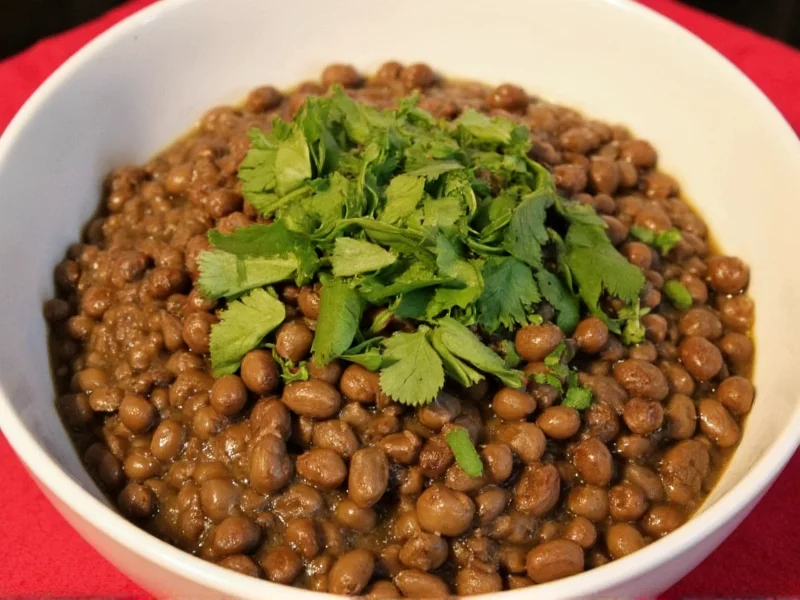Discovering what to eat with lentils transforms this humble legume from a simple ingredient into nutritionally balanced, flavorful meals. As a versatile plant-based protein source, lentils offer exceptional culinary flexibility across global cuisines while providing substantial health benefits. Understanding strategic pairings elevates both the nutritional profile and taste experience of lentil-based dishes.
Nutritional Science Behind Lentil Pairings
Lentils contain incomplete protein, lacking sufficient methionine. Pairing them with grains like rice or wheat completes the amino acid profile, creating a complete protein comparable to animal sources. This principle, known as protein complementation, makes lentil and grain combinations particularly valuable for plant-based diets.
Vitamin C dramatically increases non-heme iron absorption from lentils. Adding citrus elements or vitamin C-rich vegetables like bell peppers can boost iron uptake by up to 400%. Similarly, including healthy fats enhances absorption of fat-soluble vitamins present in accompanying vegetables.
Essential Pairing Categories
Grains That Complement Lentils
Rice remains the most traditional lentil pairing worldwide, from Middle Eastern mujadara to Indian dal. Quinoa offers a protein-rich alternative with similar cooking times. Bulgur wheat provides textural contrast in salads, while barley adds heartiness to soups. For gluten-free options, consider pairing lentils with millet or amaranth.
Vegetable Partners for Lentil Dishes
Aromatic vegetables form the flavor foundation for most lentil preparations. The classic mirepoix (onions, carrots, celery) works exceptionally well. Tomatoes add acidity that balances earthy lentil flavors. Root vegetables like sweet potatoes and beets contribute natural sweetness. Leafy greens such as spinach or kale can be stirred in at the end for added nutrients.
| Lentil Type | Best Vegetable Pairings | Recommended Cooking Method |
|---|---|---|
| Brown Lentils | Carrots, celery, tomatoes | Simmer 25-30 minutes for soups/stews |
| Green Lentils | Asparagus, zucchini, bell peppers | Simmer 20-25 minutes for salads |
| Red Lentils | Spinach, sweet potatoes, tomatoes | Simmer 15-20 minutes for curries/dals |
| Black Lentils | Beets, mushrooms, kale | Simmer 25-30 minutes for hearty dishes |
Protein Enhancements for Lentil Meals
While lentils provide substantial plant-based protein, adding complementary proteins creates more balanced meals. Chicken or turkey works well in lentil soups. Fish like salmon pairs beautifully with French green lentils. For vegetarian options, tofu or tempeh adds texture contrast. Eggs make excellent toppings for lentil salads or bowls.
Flavor Builders and Finishing Touches
Aromatic herbs like thyme, rosemary, and bay leaves enhance earthy lentil flavors during cooking. Fresh herbs including parsley, cilantro, or dill provide brightness when added at the end. Acidic elements like lemon juice or vinegar balance richness. Spices such as cumin, coriander, and turmeric create depth in curries and stews.
Global Lentil Pairing Traditions
Cultural culinary traditions offer time-tested lentil pairing wisdom. Indian cuisine combines red lentils with rice and yogurt in comforting dal meals. Middle Eastern mujadara features brown lentils with caramelized onions and bulgur. French cuisine pairs Puy lentils with vinegar-based dressings and hard-boiled eggs. Ethiopian misir wat combines lentils with berbere spice blend and served with injera bread.
Meal-Specific Pairing Recommendations
Breakfast Lentil Options
While less common, lentils can feature in morning meals. Try a lentil and vegetable hash topped with a fried egg. Alternatively, incorporate cooked lentils into savory breakfast muffins with cheese and herbs. For traditional breakfast pairings with lentil-based dishes, consider whole grain toast with avocado.
Lunchtime Lentil Combinations
Lentil salads shine at lunchtime. Combine cooked lentils with diced vegetables, fresh herbs, and a lemon-olive oil dressing. Serve over mixed greens or alongside whole grain bread. For heartier options, pair lentil soup with a crusty whole wheat roll and side salad.
Dinner Pairing Strategies
For dinner, lentils serve as excellent main components. Serve lentil curry with basmati rice and cucumber raita. Pair lentil shepherd's pie with roasted root vegetables. Create a Mediterranean lentil bowl with hummus, olives, and roasted vegetables. When planning what to serve with lentil soup for dinner, consider crusty bread and a simple green salad.
Avoiding Common Pairing Mistakes
Understanding what not to eat with lentils matters as much as good pairings. Avoid combining lentils with calcium-rich foods like dairy at the same meal, as calcium inhibits iron absorption. Don't overcomplicate flavors—lentils have earthy notes that work best with complementary rather than competing flavors. When cooking lentils, avoid adding salt too early as it can toughen the legumes.
Planning Balanced Lentil Meals
Creating nutritionally complete lentil meals requires considering all food groups. Aim for one part lentils, one part whole grains, and two parts vegetables. Include a healthy fat source and consider adding vitamin C-rich elements. When meal prepping with lentils, store components separately and combine before eating to maintain optimal texture.











 浙公网安备
33010002000092号
浙公网安备
33010002000092号 浙B2-20120091-4
浙B2-20120091-4